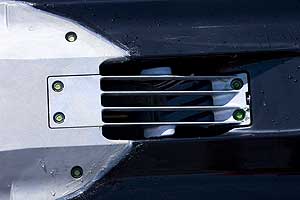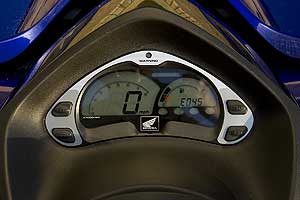Honda AquaTrax F15-X Personal Watercraft Review
Honda's new AquaTrax F15-X is a three-seater that could be the most "family friendly" personal watercraft on the market.

The Honda AquaTrax F15-X offers linear and predictable handling, with progressive over-steer as turns grow more aggressive.
Maybe horsepower doesn't really matter. When I studied the provisional spec sheet for the new Honda AquaTrax F15-X last November, and noted that the new 1470cc engine was rated at 200 hp, I figured that was no way this new boat would run with the big dogs of the high-performance three-seater set, which are claiming 250-plus horsepower. The man at American Honda assured the new AquaTrax would be competitive. And he was right.
At its first media test session last week, I packed my GPS and did a number of runs up and down-stream in the Colorado River between Lake Havasu and Topock, Arizona, and averaged 64.5 mph with a fuel load of fuel. At the end of a 66-mile day of riding, the fuel tank was down to one-third, and speed was up to about 66 mph. That's about 1 mph shy of the Yamaha FX SHO (www.yamaha-motor.com) and Kawasaki Ultra 250X (www.kawasaki.com) I recently tested, and perhaps 2 mph slower than the current king of three-seater speed, the Sea-Doo RXT-X (www.sea-doo.com). But Honda's in the hunt, and there's more than speed to like about this new AquaTrax.
I reported on the spec basics of the F15-X in November, when the boat was unveiled at the Honda dealer meeting. It's all-new from the keel up. At 11 feet 1.8 inches, it's about eight inches longer than the previous Honda three-seater, the F12-X, and about 1 inch longer than the Kawasaki Ultra. Honda publishes "ready-to-ride" curb weight (including full gas, oil, battery, etc.) of 955 pounds, but I think my estimated dry weight of 842 pounds is pretty accurate. That makes the new Honda 24 pounds heavier than the Sea-Doo RXT-X, but 62 pounds lighter than the Ultra 250X. Fuel capacity is adequate, but not generous, at 18.5 gallons.
The engine is also a new design. Displacement is up 19 percent, but Honda engineers told me the engine is actually slightly more compact than the 165-hp, 1235cc engine it replaces, thanks in part to tighter bore spacing of the four cylinders, and also to the elimination of a water-jacketed exhaust manifold. The cast manifold on the new engine is cooled with injected water. Like the previous engine, this motor has a dry-sump oiling system to help keep it low in the hull. The oil reservoir is on the front of the engine, topped with a very handy-to-reach oil filter — please take note Yamaha and Kawasaki. New on this engine is an oil thermostat, which keeps oil temp up when the boat is running in very cold water or you are cruising at a modest speed.

The Honda F15-X intake grate has "top loader" vanes to direct water to the upper portion of the pump and load the impeller evenly for better performance and efficiency.
Honda again uses a turbocharger to boost engine performance. The increased displacement and great exhaust flow of the new engine allowed Honda to drop peak boost from the 13 psi on the 1235cc engine to 10 psi on the new motor. Turbo lag — the hesitation in throttle response that occurs when a turbo "spools up" to speed — was an issue on the previous engine but has been eliminated in the F15-X. Honda switched to a single 54mm throttle body, and located the turbo and intercooler as close as possible to the intake manifold, so there's less volume that needs to be pressurized before the boost effect kicks in. Boost pressure starts in at just 2500 rpm. The larger displacement of the new motor also helps its bottom end, pre-boost, performance.
Solas builds the new 155mm pump used on the F15-X. Its impeller has been located further aft in the pump housing, a design Honda says improves efficiency and performance by providing a more-even flow of water to the blades. It's also supposed to reduce pump noise, and compared to the F12-X models that were at the Havasu ride, the F15-X was noticeably quieter as it passed by on the water. I might call the intake grate a "semi-top loader," as it has vanes only between the outboard bars, rather than across the entire grate in typical top-loader fashion (see the Sea-Doo RXT-X intake). The function of the vanes is to direct water to the top of the pump housing and so more-evenly load the impeller with a stream of water. This enhances efficiency — especially acceleration — and reduces cavitation on the blades which can make the boat quieter.
Despite its larger size, the F15-X looks a lot like the F12-X, mostly because it retains the swooping bond line (the point at which the deck joins the hull) that rises upward just forward the cowl. Covered with a new, thicker rub rail, this raised bond line helps protect the deck from scuffing on high docks and pilings. The F-15-X cockpit will feel familiar to Honda riders. The seat is outstanding, with just the right density and bolstering for all-day comfort. The handlebars, unfortunately, remain too low for comfortable stand-up riding and are not adjustable. The long run across choppy Lake Havasu left my wrists sore. I did not ride with a passenger, but the aft seat section looks wide and comfortable.

The digital dash screen on the right is scrollable to display resettable trip distance or travel time, and hour meter, a clock, and (shown here) a display that reports the remaining riding time based on available fuel and present speed. In this case, the fuel gauge shows one-third tank remaining, and 45 minutes of riding time until "E," or empty.
The smaller screen of the all-digital dash features a bar-graph fuel gauge that's easy to read, and a scrolling info screen that includes my favorite feature on this boat, a count-down "time-to-ride" display that computes real-time fuel use and fuel remaining in the tank, and then calculates how long you can ride in minutes at your present speed. For example, with 7/8 on the fuel gauge, the display told me I could ride for two hours at 30 mph, 1.5 hours at 45 mph, or just one hour at 50 mph.

An all-new 1470cc engine is rated at 197.3 hp. The oil reservoir is located on the front of the engine, topped by an oil filter and filler/dipstick that are in easy reach for servicing. The IHI turbocharger and intercooler are located just aft of the exhaust manifold, which to save weight and space does not have a water jacket — it's cooled by injected water instead.
Stowage includes a 21.4 gallon compartment in the bow, a 1.5-gallon tray below the after seat section, and a nice 1.7-gallon glove box that's deep enough for medium-size water bottles. The glove box also has a slot that designed to hold the owner's manual, but would be perfect for a keeping a wallet or registration papers secure and dry. The glove box door provides a nice example of the high-quality materials Honda has used through this boat. The plastic is not hard and brittle, but has a little flex to it. The hinge is robust, and the latch is a simple twisting device with no springs or buttons to break or get fouled by salt water. Fit-and-finish throughout is excellent.

A new 1.7-gallon glove box is deep enough to hold medium-size water bottles. The shelf on the top edge is designed to hold the owner's manual, but could also keep a wallet or registration documents in a safe, dry place.
As is the riding experience. Ergonomics are great, unless you are standing, and the ride is soft and dry through the chop. Power delivery is smooth and linear, which should make for good towing performance. Acceleration is quick, but not as brutal as the Sea-Doo RXT-X. Nor does the Honda has the razor-sharp handling of that Sea-Doo, which is simply too racy for general family use.
The Honda feels light and responsive on the water, with predictable response the steering input. Like the previous Honda three-seater, the F15-X has a slight feeling of over-steer (loose in the tail) which becomes more pronounced with aggressive riding. I could get it to snap loose but had to really launch it into a hard turn to make that happen. Of the four "high-performance" three seaters on the market, I'd say the Honda might be the most family-friendly, a nice combination of performance and predicable handling.
What could be better? I've already mentioned the low handlebars. There are no cleats or eyes to use when tying up to a dock, so we were left to loop a line over the handlebars. The hard plastic cowl sides are perfectly placed to bruise your knees. And I could not read the labels molded into the rubber buttons that control the dash display. Minor stuff, mostly.
The standard AquaTrax F15-X has a MSRP of $13,299 in Pearl White/Metallic Silver or Bright Blue Metallic. The deluxe F15-X GPScape ($14,299) has a GPS nav system, boarding step and two-tone seat that matches the exclusive Candy Red top deck. Base price is $13,299.
Editor's Note: Charles Plueddeman is the editor at large for Boating, the nation's largest recreational boating magazine.












